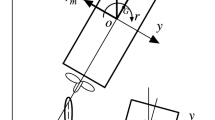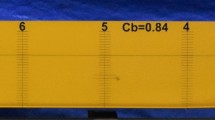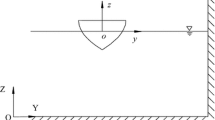Abstract
This paper discusses the effect of bilge keels on maneuverability of a fine ship experimentally and theoretically. To capture the effect, first, free-running model tests were conducted using a KCS container ship model with detachable bilge keels. We found that bilge keels improve the turning performance and enlarge overshoot angles in zig-zag maneuvers, and that this tendency becomes more pronounced with increasing ship speed. Next, captive model tests were conducted to capture the hydrodynamic forces’ effects on maneuvering to clarify the reason for the difference in maneuvering in the presence of bilge keels. By attaching bilge keels, the absolute values of \(Y_v'\), \(N_v'\), and \(K_v'\) (the linear derivatives of lateral force, yaw moment, and roll moment acting on the ship with respect to lateral velocity v, respectively) are increased and \(Y_{\phi }'\) (the derivative of the lateral force with respect to roll \(\phi\)) is also increased. It can be explained theoretically that the change of the hydrodynamic derivatives leads to course instability according to the course stability criterion presented by Yasukawa and Yoshimura [3]. The special feature of the criterion is to include the roll-coupling effect. Thus, the roll-coupling significantly affects ship maneuverability through hydrodynamic derivative changes by attaching bilge keels to fine ships with small metacentric height \(\overline{GM}\).

















Similar content being viewed by others
References
Karimata T (1974) Effect of the bilge keel on the maneuverability of ship. Mem Fac Fish Kagoshima Univ 23:71–80 (in Japanese)
Dubbioso G, Durante D, Broglia R, Mauro S (2012) Comparison of experimental and CFD results for a tanker like vessel. In: International Conference on Marine Simulation and Ship Maneuverability (MARSIM’12), Singapore (2012), USB Memory
Yasukawa H, Yoshimura Y (2014) Roll-coupling effect on ship maneuverability. Ship Technol Res 61(1):16–32
Part B: Benchmark Test Cases, KCS Description, SIMMAN (2008) Workshop on verification and validation of ship manoeuvring simulation method, Workshop Proceedings, Vol 1 Copenhagen, Denmark, pp B11–B14
Miyazaki H, Tsukada Y, Takimoto T (2013) Experimental study about the effect of the container ship’s metacenter height on the manoeuvrability, Conference Proceedings, The Japan Society of Naval Architects and Ocean Engineers, Vol 16, Paper no.2013S-OS1-6 (in Japanese)
Fukui Y, Yokota H, Yano H, Kondo M, Nakano T, Yoshimura Y (2016) 4-DOF mathematical model for manoeuvring simulation including roll motion. J Jpn Soc Naval Archit Ocean Eng 24:167–179 (in Japanese)
Hamamoto M, Kim Y-S (1993) A new coordinate system and the equations describing manoeuvring motion of a ship in waves. J Soc Naval Archit Jpn 173:209–220 (in Japanese)
Lewandowski EM (2003) The dynamics of marine craft: maneuvering and seakeeping. World Scientific Publishing Co. Inc, Hackensack (ISBN-10: 9810247560)
Yasukawa H, Yoshimura Y (2015) Introduction of MMG standard method for ship maneuvering predictions. J Mar Sci Technol 20(1):37–52
Yasukawa H, Sano M (2008) Maneuvering simulation of MOERI container ship, SIMMAN 2008, Workshop on verification and validation of ship manoeuvring simulation methods, Workshop Proceedings, Vol 1, Copenhagen, Denmark, pp E68–E73
Fujii H, Tuda T (1961) Experimental research on rudder performance (2). J Soc Naval Archit Jpn 110:31–42 (in Japanese)
Acknowledgements
This study was inspired through discussions with Dr. F. Quadvlieg of the Maritime Research Institute Nederland (MARIN), and we would like to express our thanks to him. We would like to extend our thanks to Dr. A. Matsuda and Dr. D. Terada of the National Research Institute of Fisheries Engineering, Japan, and Mr. S. Mizokami and Mr. R. Kuroiwa and their staff of the Seakeeping and Maneuvering Basin at the Nagasaki R & D Center, Mitsubishi Heavy Industries, for their help with the tank tests. This study was supported by JSPS KAKENHI Grant no. JP26249135.
Author information
Authors and Affiliations
Corresponding author
Appendices
Appendix A: captive model test results in heeled conditions
Figures 18, 19, 20, and 21 show the test results for different roll angles \(\phi =0\), \(-5\), \(-10\), and \(-15^\circ\). The results exclude the inertia force components with respect to the ship model. In each figure, the longitudinal force coefficient (\(X'\)), lateral force coefficient (\(Y'\)), yaw moment coefficient (\(N'\)) and roll moment coefficient (\(K'\)) are shown versus hull drift angle \(\beta\) for different non-dimensional yaw rates \(r'\). The dotted line plotted in the figure is the fitting line obtained using Eq. 1.
Appendix B: correction of propeller and rudder effects on linear derivatives
The following formulas were used for the correction of propeller and rudder effects on linear derivatives in the framework of the MMG model [9]:
where
Derivatives with the superscript \(*\) include the effects of the propeller and rudder. Here \(\gamma _R\) denotes the flow-straightening coefficient, \(\ell _R'\) denotes the non-dimensional effective longitudinal coordinate of rudder position, \(u_R'\) represents the non-dimensional longitudinal inflow velocity components to rudder, \(a_H\) indicates the rudder force increase factor, \(f_{\alpha }\) denotes the rudder lift gradient coefficient, \(x_H'\) is the non-dimensional longitudinal coordinate of the point at which the additional lateral force acts, and \(x_R'\) is the non-dimensional longitudinal coordinate of the rudder position (\(=-0.5\)). \(z_R'\) is the non-dimensional vertical coordinate of the position at which the rudder force acts.
After correction of propeller and rudder effects by the method mentioned above, we converted the corrected linear derivatives into derivatives about the center of gravity. Concrete values of the parameters for the correction of linear derivatives are shown in Table 7. The values were determined by referring to Yasukawa and Sano [10]. The \(\gamma _R\) listed in the table is an averaged value for port and starboard motions. The \(f_{\alpha }\) was obtained by applying Fujii’s formula [11] for a whole rudder, including the horn.
About this article
Cite this article
Yasukawa, H., Hirata, N. & Yamazaki, Y. Effect of bilge keels on maneuverability of a fine ship. J Mar Sci Technol 23, 302–318 (2018). https://doi.org/10.1007/s00773-017-0474-6
Received:
Accepted:
Published:
Issue Date:
DOI: https://doi.org/10.1007/s00773-017-0474-6








